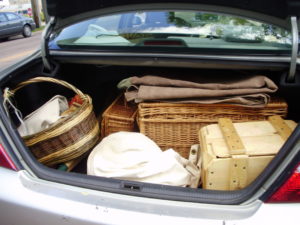
The trunk of ThelmaB’s four-wheel canoe, packed to the edges with much of our trade goods.
We have a lot of stuff! Besides three canoes and a cariole, La Compagnie has over five dozen furs, assorted camping gear, including tents, tarps and flys, and several bales, boxes and cassettes full of trade goods. In a way, we’re a portable museum of the fur trade!
But sometimes we just don’t need it all at every event.
Instead of always hauling everything, we decided to create a smaller set of goods to take to smaller events, like classroom presentations. The assortment of goods was guided by in-progress research PatrickS has made into the selection of items traders commonly sent with en dérouine expeditions.
August 4, Saturday. Today I am sending Bazinet to Ouisconsaint to try and get the Best skins from the Natives and also a small quantity of wild rice. He takes with him a small assortment of goods . . .
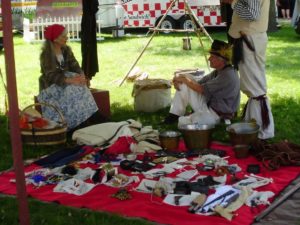
All our trade goods, ready for customers
Traders frequently sent men en dérouine as a way to encourage trade, especially with native hunters at their hunting camps. These short expeditions were one way to keep close watch on rival traders while collecting furs and trading for food at the same time.
Our new outfit, suitable for a travelling fur trade salesman, is easy to carry and includes almost a dozen and a half different items: metal tools, blankets, fabric, ready-made clothing, items of personal adornment, hunting supplies and tobacco.
While it may seem like a simple list, PatrickS says it represents hours of data entry and analysis of records like those of North West Company trader, François Victor Malhiot. Here’s the packing list PatrickS developed for us . . .
2 brasse Cloth: Over half of the items traded throughout the fur trade were fabric, especially wool. (Brasse is a French term for the length of a man’s outstretched arms, or about six feet.)
2 Blankets: One of the most popular items traded, blankets were usually white with red or blue stripes bordering either end. Size was designated by “points” . . . 4 1/2 the largest, 1 the smallest and 2 1/2 by far the most common size traded.
2 rolls Braid: What is now sometimes known as twill tape, braid came in many colors (yellow, blue, red) and a variety of fibers (silk, linen, worsted wool, even finely spun metal wire). All manner of braids, tapes, “lacing” and “ferreting” were used for trimming clothing.
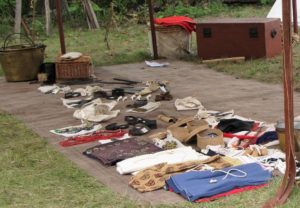
The material culture of the fur trade: all sorts of fabric, metal, jewelry and sundries
1 Silk Handkerchief: Both European and native traders wore handkerchiefs tied around their necks, probably as a fashion statement or mark of distinction. Black was especially popular as well as bright colors like red, blue and yellow.
2 Knives: For hunting and gathering peoples, knives were important tools for skinning animal hides and cutting meat. These steel knives held a sharp edge and were easier to sharpen than those made of flint or copper.
40 Balls: Shooting supplies such as lead ball and shot were frequently seen on trade shop shelves. Ball was used for hunting large game like deer while shot was used for hunting small game and birds.
1 pound Powder: By the late 17th century, guns were a universal part of the trader’s outfit as well as the necessary powder and shot. A pound of powder, carefully measured, would give a hunter more than six dozen firings.
3 twists Tobacco: Twist is the oldest form of chewing tobacco: One to three high-quality leaves were braided and twisted into a rope while green, and then cured in the same manner as other tobacco.
1 Kettle: Made of brass, tin, copper or iron, kettles were usually packed for shipping without handles as “nests”—different sizes that fit inside each other. Once at the trading post, bails (handles) were attached and the kettles sold separately.
1 Tobacco Box: Introduced to Europe by sailors who learned about tobacco through contact with native peoples, smoking began in earnest about 1560. Soldiers, sailors and traveling merchants rapidly spread its use, and new objects such as pipes, cases and boxes were exported to tempt Native American users to trade.
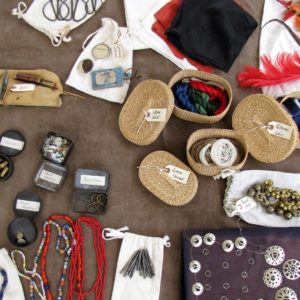
Sundries, including trade silver, cotton twist, hawk bells, plumes, silk handkerchiefs and more
4 Horn Combs: Crafted from either horn or bone, combs were among the earliest personal grooming implements crafted by humans. Bone and horn remained the standard materials for comb construction up until the advent of plastics in the 20th century.
3 packages Beads: Beads were strung into necklaces and sewn into fancy designs on bags, leggings and other clothing. At most trading posts, almost two-thirds of beads traded were blue, while nearly all of the rest were white.
6 pieces Trade Silver: Silver ornaments were a remarkable fad. Before 1750, they’re scarcely mentioned in fur trader’s records. By the 1790s, they were an essential part of any native’s outfit. Anyone who could amassed a small fortune in wearable art: armbands, earrings, gorgets and rows of pierced broaches.
12 Rings: Finger rings used in trade were usually made of silver. Some had settings of colored glass stones, while others had a round or heart shaped top piece marked with initials.
1 Shirt: Readymade shirts of linen and cotton fabrics were popular trade items. Snowy white, boldly colored, ruffled, checked, striped and shirts with striking patterns were often seen on trader’s inventories trade shop shelves.
1 pair Scarlet Leggings: Native people often preferred clothing, like leggings, made from fabric because it was lighter and warmer than fur or leather, as well as being easier to work and sew.
1 Axe: Many of the axes brought for trade were called “half-axes.” These smaller hatchets had a single blade and a flattened butt which made it handy for pounding. Like many metal trade items, they were traded without wooden handles.
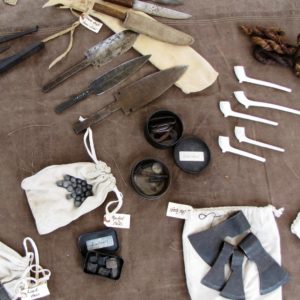
Clay pipes, twist tobacco and all manner of metal goods
Our trade goods—the “material culture” of the fur trade—helps us illustrate the fur trade history of this region. Using our collection, we can talk about history in tangible terms. We can offer visitors rich opportunities to see and touch all types of fur trade objects. By offering them a chance to study something as ordinary as a wool blanket we can lead them to think about raising sheep, weaving of wool into textiles, moving goods from the highlands of Scotland, to London, across the ocean to Montreal, then into the pays den haut before ending up at a small wintering post along the Snake River in what is now Minnesota.
Pretty good storytelling from a bunch of stuff!
To learn more about our assortment of trade goods, read A Toast to the Fur Trade: A Picture Essay on Its Material Culture by Robert Wheeler; Where Two Worlds Meet: The Great Lakes Fur Trade by Carolyn Gilman; and The Great Northwest Fur Trade, a material culture, 1763-1850 by Ryan Gale.
To learn more about North West Company trader François Victor Malhiot, read “A Wisconsin fur-trader’s journal, 1804-05” in Wisconsin Historical Collections, 19:163-233 (Madison, 1910).


A general question, do you know of any examples of native Americans using silver spoons for ornaments or jewelry?
Good question. We discussed it up at a recent meeting: the collected minds could only recall one instance from an earlier time in the literature. They suggested you investigate “The Covenant Chain” by N. Jaye Fredrickson. The general consensus is that in the time period we were most familiar with such a thing is unknown and unlikely.